Analysis of Sustainable Tourism Development in Egypt (University Name)
VerifiedAdded on 2021/02/20
|20
|6438
|57
Report
AI Summary
This report provides a comprehensive analysis of sustainable tourism development in Egypt. It begins by examining the benefits for stakeholders and the advantages and disadvantages of public/private partnerships in tourism planning. The report delves into the features of tourism development planning at different levels, including international, domestic, regional, and sub-regional. It evaluates the significance of interactive planning systems and processes, highlighting approaches like boosterism, conventional, and integrated planning. Additionally, the report assesses various methods for measuring tourist impact in Egypt. It then justifies the introduction of sustainability concepts and analyzes factors hindering sustainable tourism development, along with stages in planning for sustainability in Egypt's tourism sector. The report also explores techniques for resolving conflicts of interest, supply and demand balancing, and the moral and ethical issues of enclave tourism. Finally, it analyzes issues in developing and underdeveloped countries and provides recommendations for the future development of tourism in both Egypt and Nepal, concluding with a summary of key findings and recommendations.

Sustainable Tourism
Development
Development
Paraphrase This Document
Need a fresh take? Get an instant paraphrase of this document with our AI Paraphraser
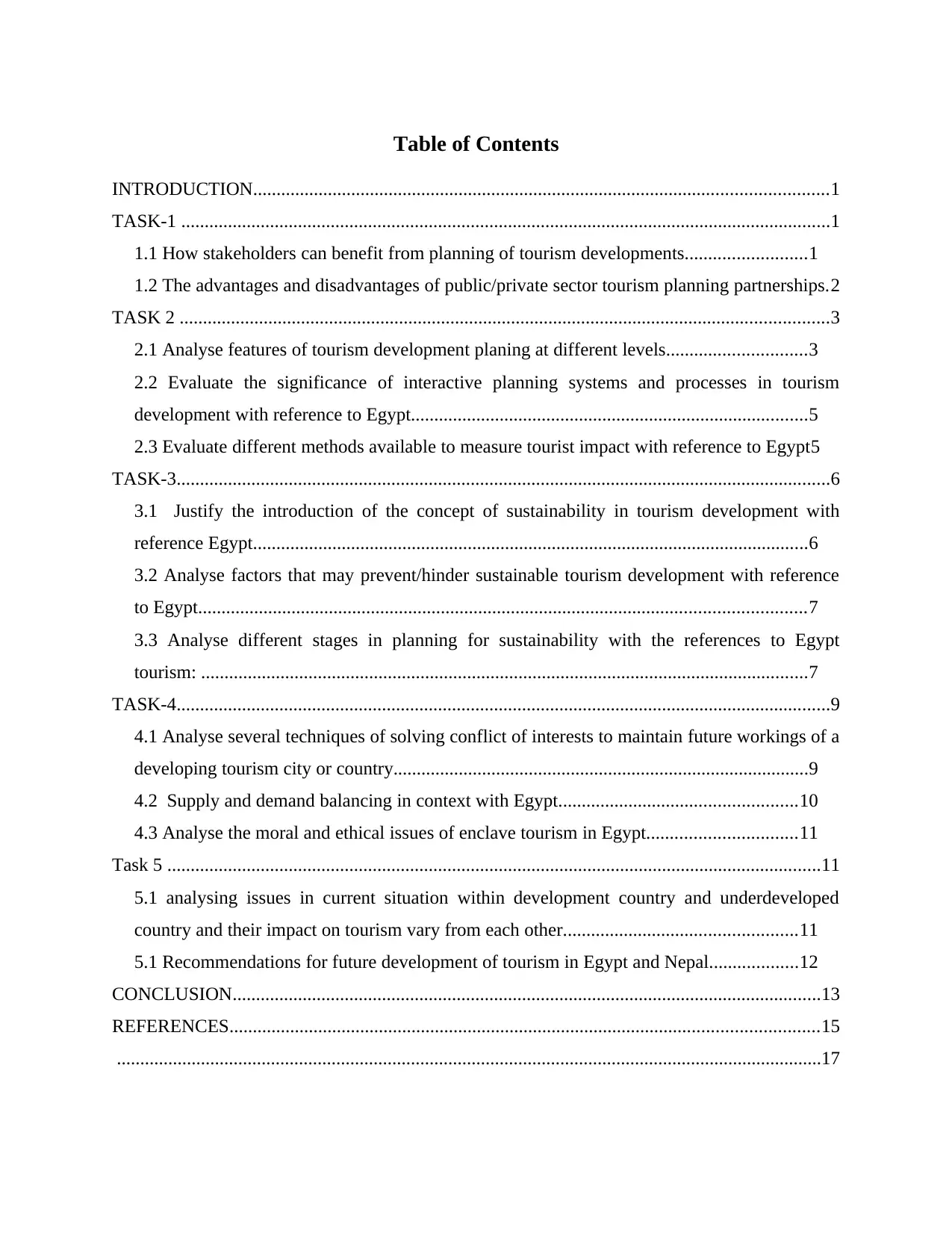
Table of Contents
INTRODUCTION...........................................................................................................................1
TASK-1 ...........................................................................................................................................1
1.1 How stakeholders can benefit from planning of tourism developments..........................1
1.2 The advantages and disadvantages of public/private sector tourism planning partnerships.2
TASK 2 ...........................................................................................................................................3
2.1 Analyse features of tourism development planing at different levels..............................3
2.2 Evaluate the significance of interactive planning systems and processes in tourism
development with reference to Egypt.....................................................................................5
2.3 Evaluate different methods available to measure tourist impact with reference to Egypt5
TASK-3............................................................................................................................................6
3.1 Justify the introduction of the concept of sustainability in tourism development with
reference Egypt.......................................................................................................................6
3.2 Analyse factors that may prevent/hinder sustainable tourism development with reference
to Egypt..................................................................................................................................7
3.3 Analyse different stages in planning for sustainability with the references to Egypt
tourism: ..................................................................................................................................7
TASK-4............................................................................................................................................9
4.1 Analyse several techniques of solving conflict of interests to maintain future workings of a
developing tourism city or country.........................................................................................9
4.2 Supply and demand balancing in context with Egypt...................................................10
4.3 Analyse the moral and ethical issues of enclave tourism in Egypt................................11
Task 5 ............................................................................................................................................11
5.1 analysing issues in current situation within development country and underdeveloped
country and their impact on tourism vary from each other..................................................11
5.1 Recommendations for future development of tourism in Egypt and Nepal...................12
CONCLUSION..............................................................................................................................13
REFERENCES..............................................................................................................................15
.......................................................................................................................................................17
INTRODUCTION...........................................................................................................................1
TASK-1 ...........................................................................................................................................1
1.1 How stakeholders can benefit from planning of tourism developments..........................1
1.2 The advantages and disadvantages of public/private sector tourism planning partnerships.2
TASK 2 ...........................................................................................................................................3
2.1 Analyse features of tourism development planing at different levels..............................3
2.2 Evaluate the significance of interactive planning systems and processes in tourism
development with reference to Egypt.....................................................................................5
2.3 Evaluate different methods available to measure tourist impact with reference to Egypt5
TASK-3............................................................................................................................................6
3.1 Justify the introduction of the concept of sustainability in tourism development with
reference Egypt.......................................................................................................................6
3.2 Analyse factors that may prevent/hinder sustainable tourism development with reference
to Egypt..................................................................................................................................7
3.3 Analyse different stages in planning for sustainability with the references to Egypt
tourism: ..................................................................................................................................7
TASK-4............................................................................................................................................9
4.1 Analyse several techniques of solving conflict of interests to maintain future workings of a
developing tourism city or country.........................................................................................9
4.2 Supply and demand balancing in context with Egypt...................................................10
4.3 Analyse the moral and ethical issues of enclave tourism in Egypt................................11
Task 5 ............................................................................................................................................11
5.1 analysing issues in current situation within development country and underdeveloped
country and their impact on tourism vary from each other..................................................11
5.1 Recommendations for future development of tourism in Egypt and Nepal...................12
CONCLUSION..............................................................................................................................13
REFERENCES..............................................................................................................................15
.......................................................................................................................................................17

⊘ This is a preview!⊘
Do you want full access?
Subscribe today to unlock all pages.

Trusted by 1+ million students worldwide
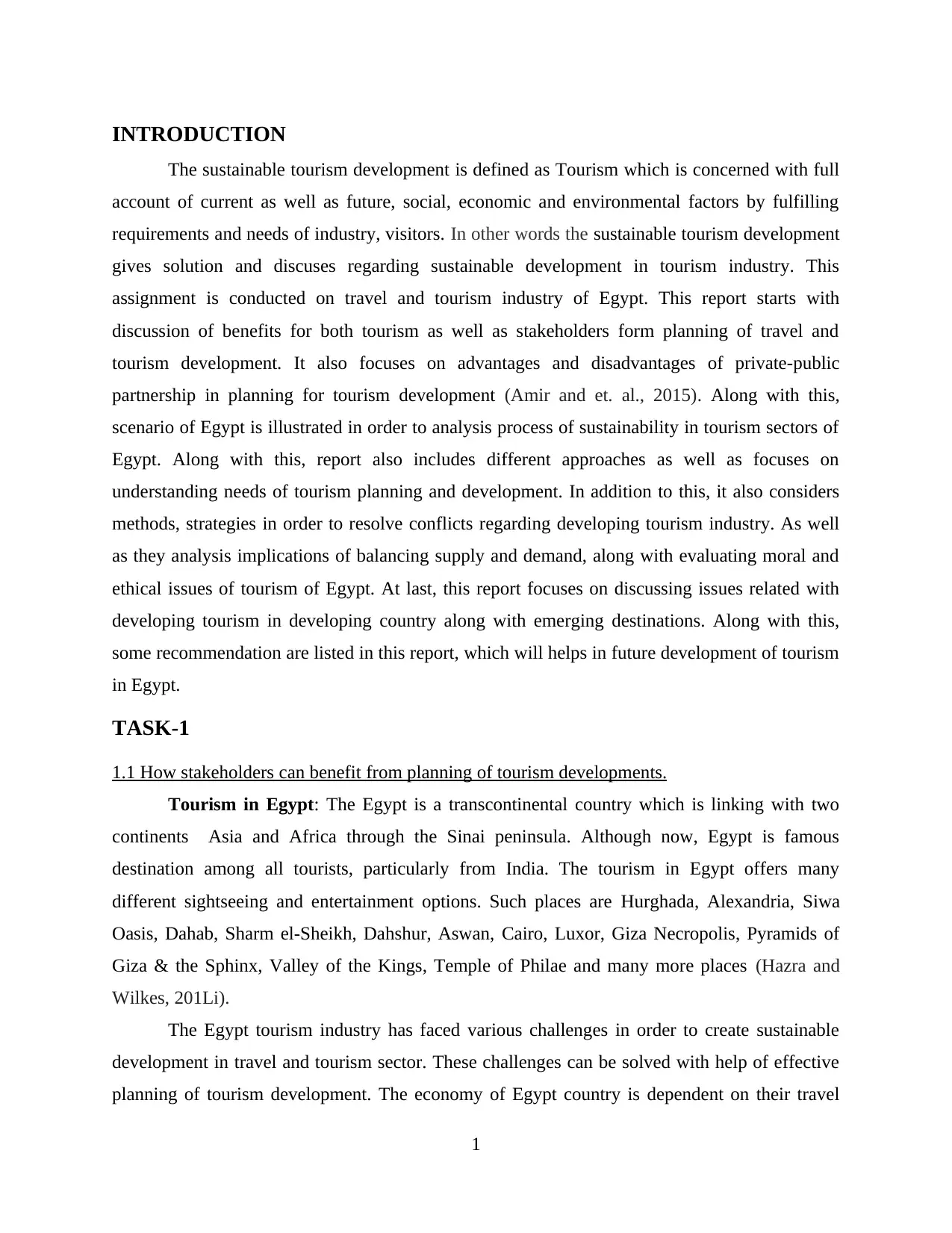
INTRODUCTION
The sustainable tourism development is defined as Tourism which is concerned with full
account of current as well as future, social, economic and environmental factors by fulfilling
requirements and needs of industry, visitors. In other words the sustainable tourism development
gives solution and discuses regarding sustainable development in tourism industry. This
assignment is conducted on travel and tourism industry of Egypt. This report starts with
discussion of benefits for both tourism as well as stakeholders form planning of travel and
tourism development. It also focuses on advantages and disadvantages of private-public
partnership in planning for tourism development (Amir and et. al., 2015). Along with this,
scenario of Egypt is illustrated in order to analysis process of sustainability in tourism sectors of
Egypt. Along with this, report also includes different approaches as well as focuses on
understanding needs of tourism planning and development. In addition to this, it also considers
methods, strategies in order to resolve conflicts regarding developing tourism industry. As well
as they analysis implications of balancing supply and demand, along with evaluating moral and
ethical issues of tourism of Egypt. At last, this report focuses on discussing issues related with
developing tourism in developing country along with emerging destinations. Along with this,
some recommendation are listed in this report, which will helps in future development of tourism
in Egypt.
TASK-1
1.1 How stakeholders can benefit from planning of tourism developments.
Tourism in Egypt: The Egypt is a transcontinental country which is linking with two
continents Asia and Africa through the Sinai peninsula. Although now, Egypt is famous
destination among all tourists, particularly from India. The tourism in Egypt offers many
different sightseeing and entertainment options. Such places are Hurghada, Alexandria, Siwa
Oasis, Dahab, Sharm el-Sheikh, Dahshur, Aswan, Cairo, Luxor, Giza Necropolis, Pyramids of
Giza & the Sphinx, Valley of the Kings, Temple of Philae and many more places (Hazra and
Wilkes, 201Li).
The Egypt tourism industry has faced various challenges in order to create sustainable
development in travel and tourism sector. These challenges can be solved with help of effective
planning of tourism development. The economy of Egypt country is dependent on their travel
1
The sustainable tourism development is defined as Tourism which is concerned with full
account of current as well as future, social, economic and environmental factors by fulfilling
requirements and needs of industry, visitors. In other words the sustainable tourism development
gives solution and discuses regarding sustainable development in tourism industry. This
assignment is conducted on travel and tourism industry of Egypt. This report starts with
discussion of benefits for both tourism as well as stakeholders form planning of travel and
tourism development. It also focuses on advantages and disadvantages of private-public
partnership in planning for tourism development (Amir and et. al., 2015). Along with this,
scenario of Egypt is illustrated in order to analysis process of sustainability in tourism sectors of
Egypt. Along with this, report also includes different approaches as well as focuses on
understanding needs of tourism planning and development. In addition to this, it also considers
methods, strategies in order to resolve conflicts regarding developing tourism industry. As well
as they analysis implications of balancing supply and demand, along with evaluating moral and
ethical issues of tourism of Egypt. At last, this report focuses on discussing issues related with
developing tourism in developing country along with emerging destinations. Along with this,
some recommendation are listed in this report, which will helps in future development of tourism
in Egypt.
TASK-1
1.1 How stakeholders can benefit from planning of tourism developments.
Tourism in Egypt: The Egypt is a transcontinental country which is linking with two
continents Asia and Africa through the Sinai peninsula. Although now, Egypt is famous
destination among all tourists, particularly from India. The tourism in Egypt offers many
different sightseeing and entertainment options. Such places are Hurghada, Alexandria, Siwa
Oasis, Dahab, Sharm el-Sheikh, Dahshur, Aswan, Cairo, Luxor, Giza Necropolis, Pyramids of
Giza & the Sphinx, Valley of the Kings, Temple of Philae and many more places (Hazra and
Wilkes, 201Li).
The Egypt tourism industry has faced various challenges in order to create sustainable
development in travel and tourism sector. These challenges can be solved with help of effective
planning of tourism development. The economy of Egypt country is dependent on their travel
1
Paraphrase This Document
Need a fresh take? Get an instant paraphrase of this document with our AI Paraphraser
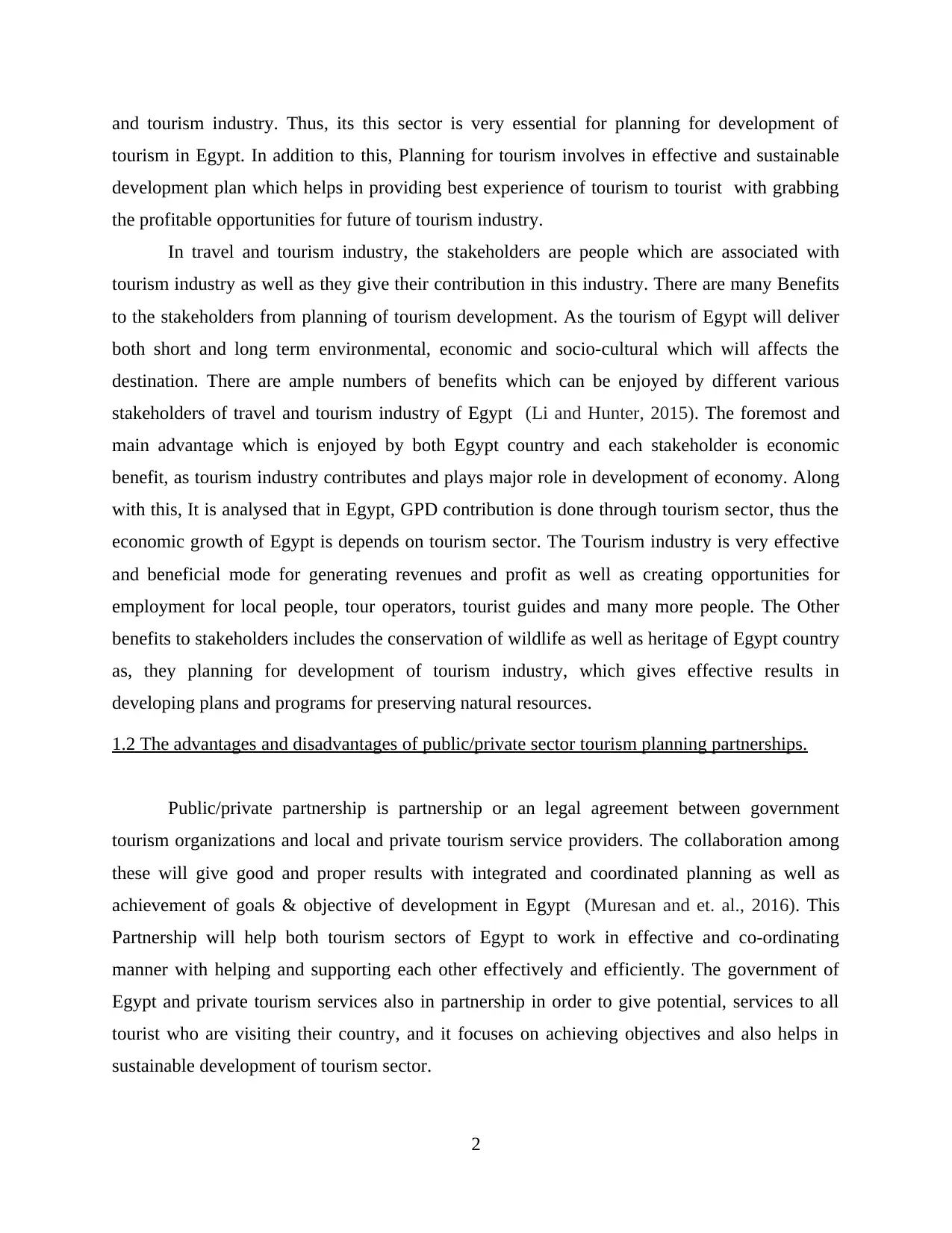
and tourism industry. Thus, its this sector is very essential for planning for development of
tourism in Egypt. In addition to this, Planning for tourism involves in effective and sustainable
development plan which helps in providing best experience of tourism to tourist with grabbing
the profitable opportunities for future of tourism industry.
In travel and tourism industry, the stakeholders are people which are associated with
tourism industry as well as they give their contribution in this industry. There are many Benefits
to the stakeholders from planning of tourism development. As the tourism of Egypt will deliver
both short and long term environmental, economic and socio-cultural which will affects the
destination. There are ample numbers of benefits which can be enjoyed by different various
stakeholders of travel and tourism industry of Egypt (Li and Hunter, 2015). The foremost and
main advantage which is enjoyed by both Egypt country and each stakeholder is economic
benefit, as tourism industry contributes and plays major role in development of economy. Along
with this, It is analysed that in Egypt, GPD contribution is done through tourism sector, thus the
economic growth of Egypt is depends on tourism sector. The Tourism industry is very effective
and beneficial mode for generating revenues and profit as well as creating opportunities for
employment for local people, tour operators, tourist guides and many more people. The Other
benefits to stakeholders includes the conservation of wildlife as well as heritage of Egypt country
as, they planning for development of tourism industry, which gives effective results in
developing plans and programs for preserving natural resources.
1.2 The advantages and disadvantages of public/private sector tourism planning partnerships.
Public/private partnership is partnership or an legal agreement between government
tourism organizations and local and private tourism service providers. The collaboration among
these will give good and proper results with integrated and coordinated planning as well as
achievement of goals & objective of development in Egypt (Muresan and et. al., 2016). This
Partnership will help both tourism sectors of Egypt to work in effective and co-ordinating
manner with helping and supporting each other effectively and efficiently. The government of
Egypt and private tourism services also in partnership in order to give potential, services to all
tourist who are visiting their country, and it focuses on achieving objectives and also helps in
sustainable development of tourism sector.
2
tourism in Egypt. In addition to this, Planning for tourism involves in effective and sustainable
development plan which helps in providing best experience of tourism to tourist with grabbing
the profitable opportunities for future of tourism industry.
In travel and tourism industry, the stakeholders are people which are associated with
tourism industry as well as they give their contribution in this industry. There are many Benefits
to the stakeholders from planning of tourism development. As the tourism of Egypt will deliver
both short and long term environmental, economic and socio-cultural which will affects the
destination. There are ample numbers of benefits which can be enjoyed by different various
stakeholders of travel and tourism industry of Egypt (Li and Hunter, 2015). The foremost and
main advantage which is enjoyed by both Egypt country and each stakeholder is economic
benefit, as tourism industry contributes and plays major role in development of economy. Along
with this, It is analysed that in Egypt, GPD contribution is done through tourism sector, thus the
economic growth of Egypt is depends on tourism sector. The Tourism industry is very effective
and beneficial mode for generating revenues and profit as well as creating opportunities for
employment for local people, tour operators, tourist guides and many more people. The Other
benefits to stakeholders includes the conservation of wildlife as well as heritage of Egypt country
as, they planning for development of tourism industry, which gives effective results in
developing plans and programs for preserving natural resources.
1.2 The advantages and disadvantages of public/private sector tourism planning partnerships.
Public/private partnership is partnership or an legal agreement between government
tourism organizations and local and private tourism service providers. The collaboration among
these will give good and proper results with integrated and coordinated planning as well as
achievement of goals & objective of development in Egypt (Muresan and et. al., 2016). This
Partnership will help both tourism sectors of Egypt to work in effective and co-ordinating
manner with helping and supporting each other effectively and efficiently. The government of
Egypt and private tourism services also in partnership in order to give potential, services to all
tourist who are visiting their country, and it focuses on achieving objectives and also helps in
sustainable development of tourism sector.
2
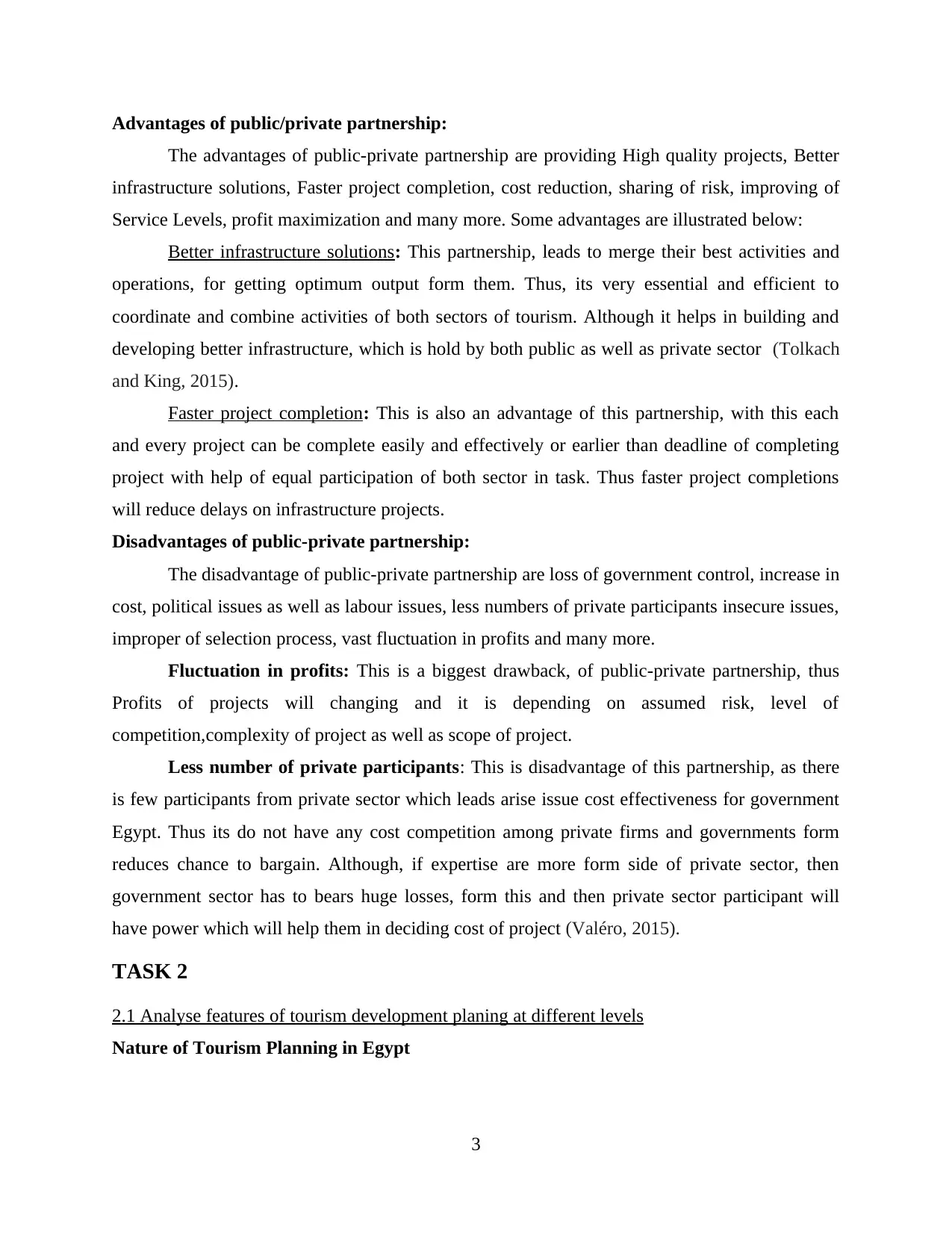
Advantages of public/private partnership:
The advantages of public-private partnership are providing High quality projects, Better
infrastructure solutions, Faster project completion, cost reduction, sharing of risk, improving of
Service Levels, profit maximization and many more. Some advantages are illustrated below:
Better infrastructure solutions: This partnership, leads to merge their best activities and
operations, for getting optimum output form them. Thus, its very essential and efficient to
coordinate and combine activities of both sectors of tourism. Although it helps in building and
developing better infrastructure, which is hold by both public as well as private sector (Tolkach
and King, 2015).
Faster project completion: This is also an advantage of this partnership, with this each
and every project can be complete easily and effectively or earlier than deadline of completing
project with help of equal participation of both sector in task. Thus faster project completions
will reduce delays on infrastructure projects.
Disadvantages of public-private partnership:
The disadvantage of public-private partnership are loss of government control, increase in
cost, political issues as well as labour issues, less numbers of private participants insecure issues,
improper of selection process, vast fluctuation in profits and many more.
Fluctuation in profits: This is a biggest drawback, of public-private partnership, thus
Profits of projects will changing and it is depending on assumed risk, level of
competition,complexity of project as well as scope of project.
Less number of private participants: This is disadvantage of this partnership, as there
is few participants from private sector which leads arise issue cost effectiveness for government
Egypt. Thus its do not have any cost competition among private firms and governments form
reduces chance to bargain. Although, if expertise are more form side of private sector, then
government sector has to bears huge losses, form this and then private sector participant will
have power which will help them in deciding cost of project (Valéro, 2015).
TASK 2
2.1 Analyse features of tourism development planing at different levels
Nature of Tourism Planning in Egypt
3
The advantages of public-private partnership are providing High quality projects, Better
infrastructure solutions, Faster project completion, cost reduction, sharing of risk, improving of
Service Levels, profit maximization and many more. Some advantages are illustrated below:
Better infrastructure solutions: This partnership, leads to merge their best activities and
operations, for getting optimum output form them. Thus, its very essential and efficient to
coordinate and combine activities of both sectors of tourism. Although it helps in building and
developing better infrastructure, which is hold by both public as well as private sector (Tolkach
and King, 2015).
Faster project completion: This is also an advantage of this partnership, with this each
and every project can be complete easily and effectively or earlier than deadline of completing
project with help of equal participation of both sector in task. Thus faster project completions
will reduce delays on infrastructure projects.
Disadvantages of public-private partnership:
The disadvantage of public-private partnership are loss of government control, increase in
cost, political issues as well as labour issues, less numbers of private participants insecure issues,
improper of selection process, vast fluctuation in profits and many more.
Fluctuation in profits: This is a biggest drawback, of public-private partnership, thus
Profits of projects will changing and it is depending on assumed risk, level of
competition,complexity of project as well as scope of project.
Less number of private participants: This is disadvantage of this partnership, as there
is few participants from private sector which leads arise issue cost effectiveness for government
Egypt. Thus its do not have any cost competition among private firms and governments form
reduces chance to bargain. Although, if expertise are more form side of private sector, then
government sector has to bears huge losses, form this and then private sector participant will
have power which will help them in deciding cost of project (Valéro, 2015).
TASK 2
2.1 Analyse features of tourism development planing at different levels
Nature of Tourism Planning in Egypt
3
⊘ This is a preview!⊘
Do you want full access?
Subscribe today to unlock all pages.

Trusted by 1+ million students worldwide
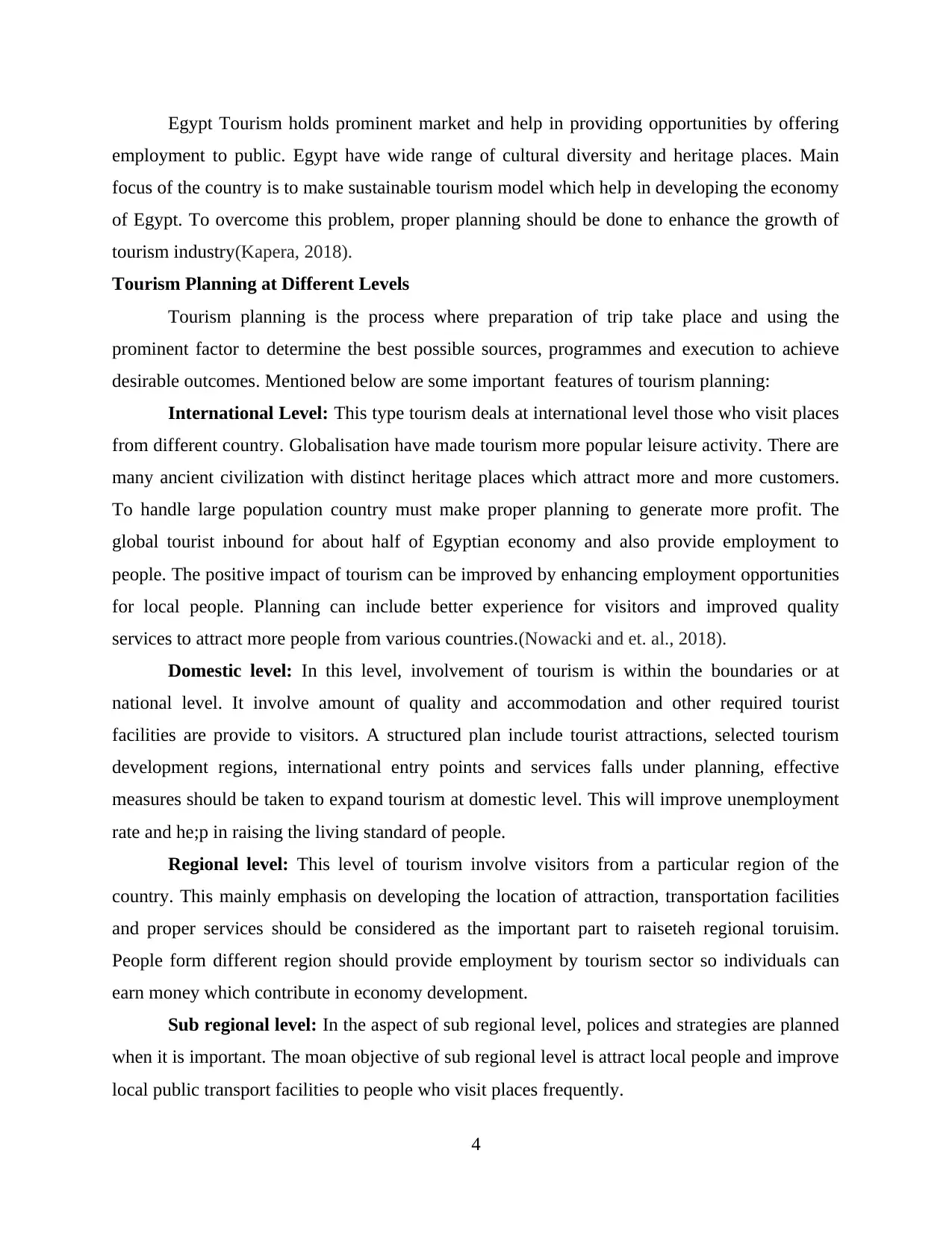
Egypt Tourism holds prominent market and help in providing opportunities by offering
employment to public. Egypt have wide range of cultural diversity and heritage places. Main
focus of the country is to make sustainable tourism model which help in developing the economy
of Egypt. To overcome this problem, proper planning should be done to enhance the growth of
tourism industry(Kapera, 2018).
Tourism Planning at Different Levels
Tourism planning is the process where preparation of trip take place and using the
prominent factor to determine the best possible sources, programmes and execution to achieve
desirable outcomes. Mentioned below are some important features of tourism planning:
International Level: This type tourism deals at international level those who visit places
from different country. Globalisation have made tourism more popular leisure activity. There are
many ancient civilization with distinct heritage places which attract more and more customers.
To handle large population country must make proper planning to generate more profit. The
global tourist inbound for about half of Egyptian economy and also provide employment to
people. The positive impact of tourism can be improved by enhancing employment opportunities
for local people. Planning can include better experience for visitors and improved quality
services to attract more people from various countries.(Nowacki and et. al., 2018).
Domestic level: In this level, involvement of tourism is within the boundaries or at
national level. It involve amount of quality and accommodation and other required tourist
facilities are provide to visitors. A structured plan include tourist attractions, selected tourism
development regions, international entry points and services falls under planning, effective
measures should be taken to expand tourism at domestic level. This will improve unemployment
rate and he;p in raising the living standard of people.
Regional level: This level of tourism involve visitors from a particular region of the
country. This mainly emphasis on developing the location of attraction, transportation facilities
and proper services should be considered as the important part to raiseteh regional toruisim.
People form different region should provide employment by tourism sector so individuals can
earn money which contribute in economy development.
Sub regional level: In the aspect of sub regional level, polices and strategies are planned
when it is important. The moan objective of sub regional level is attract local people and improve
local public transport facilities to people who visit places frequently.
4
employment to public. Egypt have wide range of cultural diversity and heritage places. Main
focus of the country is to make sustainable tourism model which help in developing the economy
of Egypt. To overcome this problem, proper planning should be done to enhance the growth of
tourism industry(Kapera, 2018).
Tourism Planning at Different Levels
Tourism planning is the process where preparation of trip take place and using the
prominent factor to determine the best possible sources, programmes and execution to achieve
desirable outcomes. Mentioned below are some important features of tourism planning:
International Level: This type tourism deals at international level those who visit places
from different country. Globalisation have made tourism more popular leisure activity. There are
many ancient civilization with distinct heritage places which attract more and more customers.
To handle large population country must make proper planning to generate more profit. The
global tourist inbound for about half of Egyptian economy and also provide employment to
people. The positive impact of tourism can be improved by enhancing employment opportunities
for local people. Planning can include better experience for visitors and improved quality
services to attract more people from various countries.(Nowacki and et. al., 2018).
Domestic level: In this level, involvement of tourism is within the boundaries or at
national level. It involve amount of quality and accommodation and other required tourist
facilities are provide to visitors. A structured plan include tourist attractions, selected tourism
development regions, international entry points and services falls under planning, effective
measures should be taken to expand tourism at domestic level. This will improve unemployment
rate and he;p in raising the living standard of people.
Regional level: This level of tourism involve visitors from a particular region of the
country. This mainly emphasis on developing the location of attraction, transportation facilities
and proper services should be considered as the important part to raiseteh regional toruisim.
People form different region should provide employment by tourism sector so individuals can
earn money which contribute in economy development.
Sub regional level: In the aspect of sub regional level, polices and strategies are planned
when it is important. The moan objective of sub regional level is attract local people and improve
local public transport facilities to people who visit places frequently.
4
Paraphrase This Document
Need a fresh take? Get an instant paraphrase of this document with our AI Paraphraser
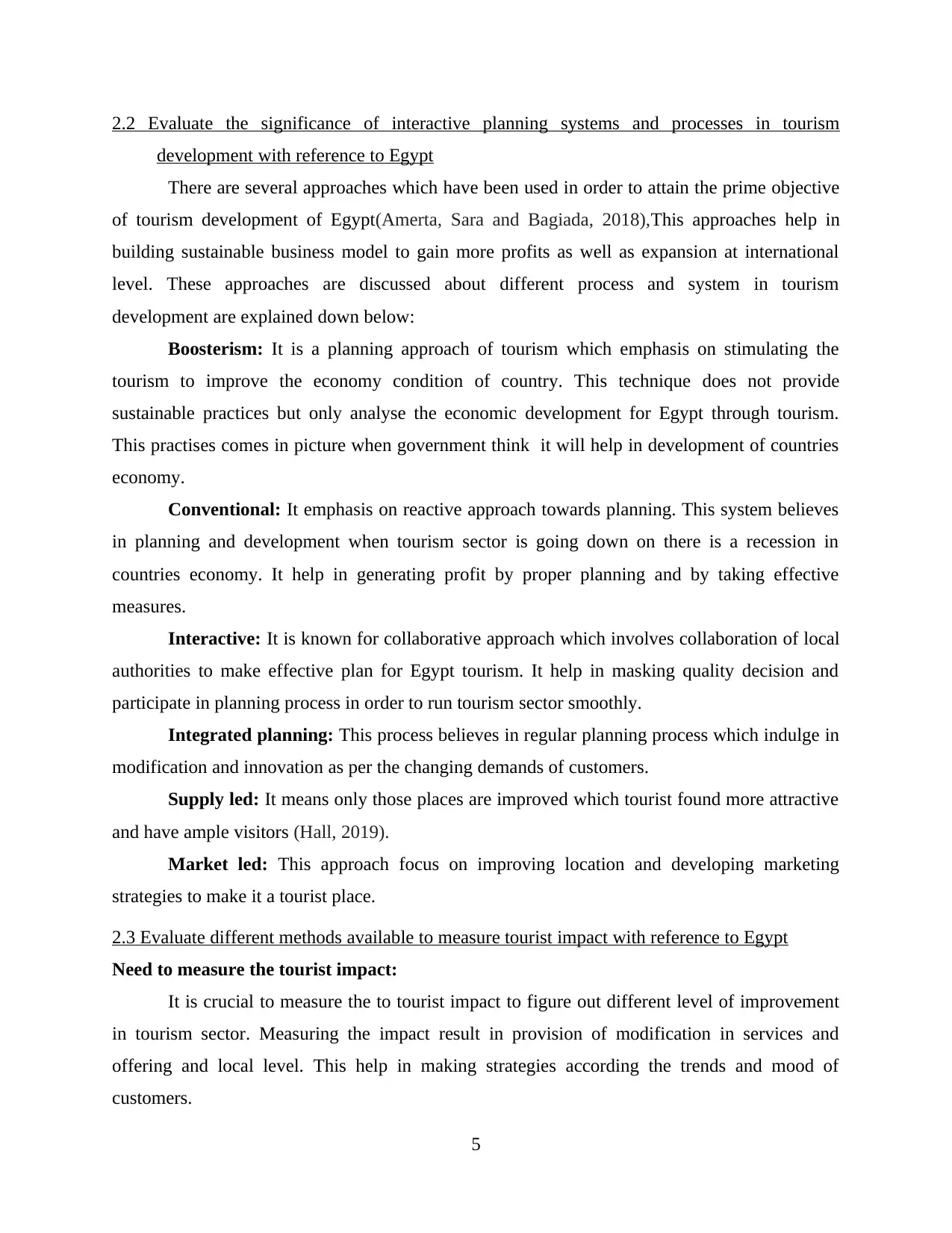
2.2 Evaluate the significance of interactive planning systems and processes in tourism
development with reference to Egypt
There are several approaches which have been used in order to attain the prime objective
of tourism development of Egypt(Amerta, Sara and Bagiada, 2018),This approaches help in
building sustainable business model to gain more profits as well as expansion at international
level. These approaches are discussed about different process and system in tourism
development are explained down below:
Boosterism: It is a planning approach of tourism which emphasis on stimulating the
tourism to improve the economy condition of country. This technique does not provide
sustainable practices but only analyse the economic development for Egypt through tourism.
This practises comes in picture when government think it will help in development of countries
economy.
Conventional: It emphasis on reactive approach towards planning. This system believes
in planning and development when tourism sector is going down on there is a recession in
countries economy. It help in generating profit by proper planning and by taking effective
measures.
Interactive: It is known for collaborative approach which involves collaboration of local
authorities to make effective plan for Egypt tourism. It help in masking quality decision and
participate in planning process in order to run tourism sector smoothly.
Integrated planning: This process believes in regular planning process which indulge in
modification and innovation as per the changing demands of customers.
Supply led: It means only those places are improved which tourist found more attractive
and have ample visitors (Hall, 2019).
Market led: This approach focus on improving location and developing marketing
strategies to make it a tourist place.
2.3 Evaluate different methods available to measure tourist impact with reference to Egypt
Need to measure the tourist impact:
It is crucial to measure the to tourist impact to figure out different level of improvement
in tourism sector. Measuring the impact result in provision of modification in services and
offering and local level. This help in making strategies according the trends and mood of
customers.
5
development with reference to Egypt
There are several approaches which have been used in order to attain the prime objective
of tourism development of Egypt(Amerta, Sara and Bagiada, 2018),This approaches help in
building sustainable business model to gain more profits as well as expansion at international
level. These approaches are discussed about different process and system in tourism
development are explained down below:
Boosterism: It is a planning approach of tourism which emphasis on stimulating the
tourism to improve the economy condition of country. This technique does not provide
sustainable practices but only analyse the economic development for Egypt through tourism.
This practises comes in picture when government think it will help in development of countries
economy.
Conventional: It emphasis on reactive approach towards planning. This system believes
in planning and development when tourism sector is going down on there is a recession in
countries economy. It help in generating profit by proper planning and by taking effective
measures.
Interactive: It is known for collaborative approach which involves collaboration of local
authorities to make effective plan for Egypt tourism. It help in masking quality decision and
participate in planning process in order to run tourism sector smoothly.
Integrated planning: This process believes in regular planning process which indulge in
modification and innovation as per the changing demands of customers.
Supply led: It means only those places are improved which tourist found more attractive
and have ample visitors (Hall, 2019).
Market led: This approach focus on improving location and developing marketing
strategies to make it a tourist place.
2.3 Evaluate different methods available to measure tourist impact with reference to Egypt
Need to measure the tourist impact:
It is crucial to measure the to tourist impact to figure out different level of improvement
in tourism sector. Measuring the impact result in provision of modification in services and
offering and local level. This help in making strategies according the trends and mood of
customers.
5
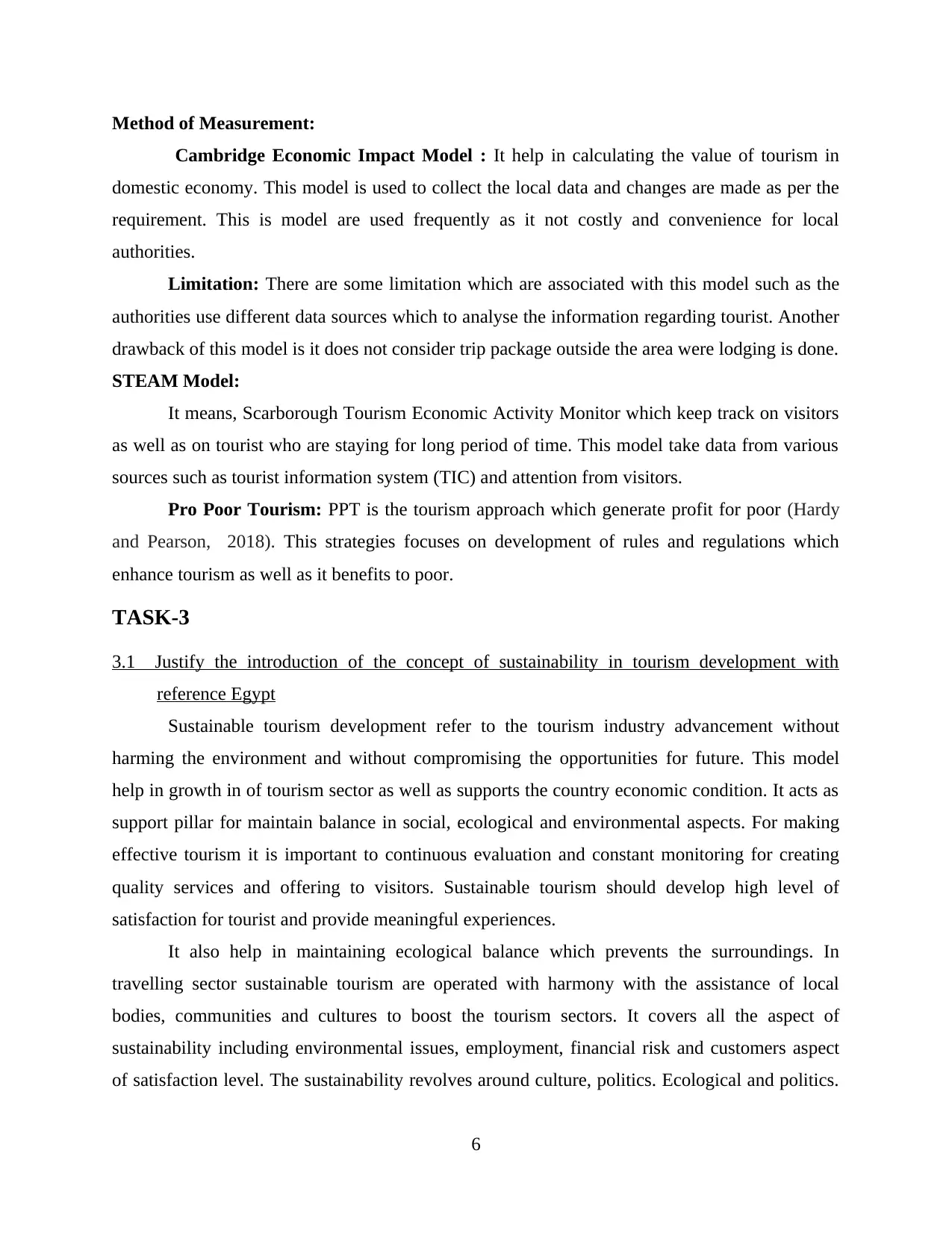
Method of Measurement:
Cambridge Economic Impact Model : It help in calculating the value of tourism in
domestic economy. This model is used to collect the local data and changes are made as per the
requirement. This is model are used frequently as it not costly and convenience for local
authorities.
Limitation: There are some limitation which are associated with this model such as the
authorities use different data sources which to analyse the information regarding tourist. Another
drawback of this model is it does not consider trip package outside the area were lodging is done.
STEAM Model:
It means, Scarborough Tourism Economic Activity Monitor which keep track on visitors
as well as on tourist who are staying for long period of time. This model take data from various
sources such as tourist information system (TIC) and attention from visitors.
Pro Poor Tourism: PPT is the tourism approach which generate profit for poor (Hardy
and Pearson, 2018). This strategies focuses on development of rules and regulations which
enhance tourism as well as it benefits to poor.
TASK-3
3.1 Justify the introduction of the concept of sustainability in tourism development with
reference Egypt
Sustainable tourism development refer to the tourism industry advancement without
harming the environment and without compromising the opportunities for future. This model
help in growth in of tourism sector as well as supports the country economic condition. It acts as
support pillar for maintain balance in social, ecological and environmental aspects. For making
effective tourism it is important to continuous evaluation and constant monitoring for creating
quality services and offering to visitors. Sustainable tourism should develop high level of
satisfaction for tourist and provide meaningful experiences.
It also help in maintaining ecological balance which prevents the surroundings. In
travelling sector sustainable tourism are operated with harmony with the assistance of local
bodies, communities and cultures to boost the tourism sectors. It covers all the aspect of
sustainability including environmental issues, employment, financial risk and customers aspect
of satisfaction level. The sustainability revolves around culture, politics. Ecological and politics.
6
Cambridge Economic Impact Model : It help in calculating the value of tourism in
domestic economy. This model is used to collect the local data and changes are made as per the
requirement. This is model are used frequently as it not costly and convenience for local
authorities.
Limitation: There are some limitation which are associated with this model such as the
authorities use different data sources which to analyse the information regarding tourist. Another
drawback of this model is it does not consider trip package outside the area were lodging is done.
STEAM Model:
It means, Scarborough Tourism Economic Activity Monitor which keep track on visitors
as well as on tourist who are staying for long period of time. This model take data from various
sources such as tourist information system (TIC) and attention from visitors.
Pro Poor Tourism: PPT is the tourism approach which generate profit for poor (Hardy
and Pearson, 2018). This strategies focuses on development of rules and regulations which
enhance tourism as well as it benefits to poor.
TASK-3
3.1 Justify the introduction of the concept of sustainability in tourism development with
reference Egypt
Sustainable tourism development refer to the tourism industry advancement without
harming the environment and without compromising the opportunities for future. This model
help in growth in of tourism sector as well as supports the country economic condition. It acts as
support pillar for maintain balance in social, ecological and environmental aspects. For making
effective tourism it is important to continuous evaluation and constant monitoring for creating
quality services and offering to visitors. Sustainable tourism should develop high level of
satisfaction for tourist and provide meaningful experiences.
It also help in maintaining ecological balance which prevents the surroundings. In
travelling sector sustainable tourism are operated with harmony with the assistance of local
bodies, communities and cultures to boost the tourism sectors. It covers all the aspect of
sustainability including environmental issues, employment, financial risk and customers aspect
of satisfaction level. The sustainability revolves around culture, politics. Ecological and politics.
6
⊘ This is a preview!⊘
Do you want full access?
Subscribe today to unlock all pages.

Trusted by 1+ million students worldwide
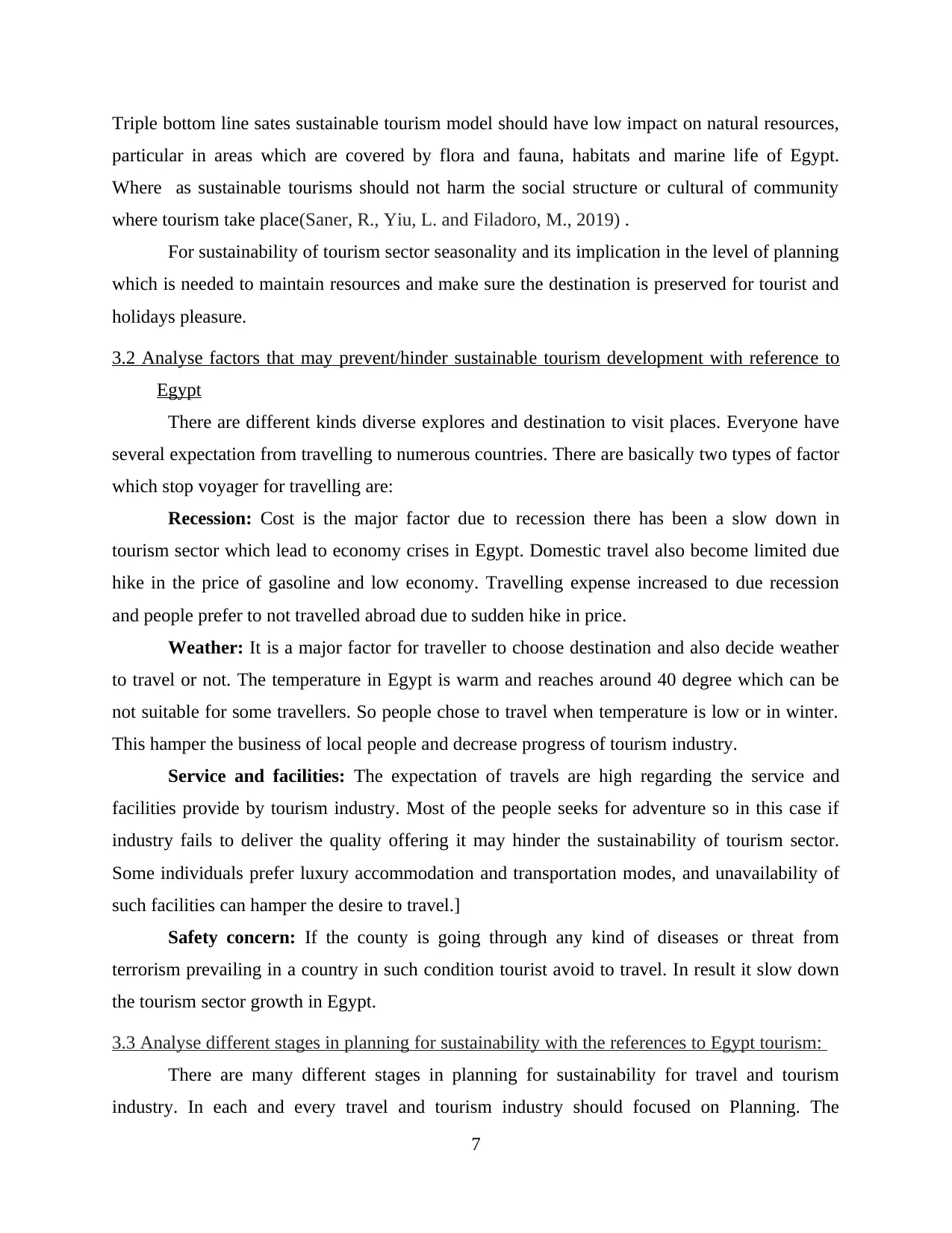
Triple bottom line sates sustainable tourism model should have low impact on natural resources,
particular in areas which are covered by flora and fauna, habitats and marine life of Egypt.
Where as sustainable tourisms should not harm the social structure or cultural of community
where tourism take place(Saner, R., Yiu, L. and Filadoro, M., 2019) .
For sustainability of tourism sector seasonality and its implication in the level of planning
which is needed to maintain resources and make sure the destination is preserved for tourist and
holidays pleasure.
3.2 Analyse factors that may prevent/hinder sustainable tourism development with reference to
Egypt
There are different kinds diverse explores and destination to visit places. Everyone have
several expectation from travelling to numerous countries. There are basically two types of factor
which stop voyager for travelling are:
Recession: Cost is the major factor due to recession there has been a slow down in
tourism sector which lead to economy crises in Egypt. Domestic travel also become limited due
hike in the price of gasoline and low economy. Travelling expense increased to due recession
and people prefer to not travelled abroad due to sudden hike in price.
Weather: It is a major factor for traveller to choose destination and also decide weather
to travel or not. The temperature in Egypt is warm and reaches around 40 degree which can be
not suitable for some travellers. So people chose to travel when temperature is low or in winter.
This hamper the business of local people and decrease progress of tourism industry.
Service and facilities: The expectation of travels are high regarding the service and
facilities provide by tourism industry. Most of the people seeks for adventure so in this case if
industry fails to deliver the quality offering it may hinder the sustainability of tourism sector.
Some individuals prefer luxury accommodation and transportation modes, and unavailability of
such facilities can hamper the desire to travel.]
Safety concern: If the county is going through any kind of diseases or threat from
terrorism prevailing in a country in such condition tourist avoid to travel. In result it slow down
the tourism sector growth in Egypt.
3.3 Analyse different stages in planning for sustainability with the references to Egypt tourism:
There are many different stages in planning for sustainability for travel and tourism
industry. In each and every travel and tourism industry should focused on Planning. The
7
particular in areas which are covered by flora and fauna, habitats and marine life of Egypt.
Where as sustainable tourisms should not harm the social structure or cultural of community
where tourism take place(Saner, R., Yiu, L. and Filadoro, M., 2019) .
For sustainability of tourism sector seasonality and its implication in the level of planning
which is needed to maintain resources and make sure the destination is preserved for tourist and
holidays pleasure.
3.2 Analyse factors that may prevent/hinder sustainable tourism development with reference to
Egypt
There are different kinds diverse explores and destination to visit places. Everyone have
several expectation from travelling to numerous countries. There are basically two types of factor
which stop voyager for travelling are:
Recession: Cost is the major factor due to recession there has been a slow down in
tourism sector which lead to economy crises in Egypt. Domestic travel also become limited due
hike in the price of gasoline and low economy. Travelling expense increased to due recession
and people prefer to not travelled abroad due to sudden hike in price.
Weather: It is a major factor for traveller to choose destination and also decide weather
to travel or not. The temperature in Egypt is warm and reaches around 40 degree which can be
not suitable for some travellers. So people chose to travel when temperature is low or in winter.
This hamper the business of local people and decrease progress of tourism industry.
Service and facilities: The expectation of travels are high regarding the service and
facilities provide by tourism industry. Most of the people seeks for adventure so in this case if
industry fails to deliver the quality offering it may hinder the sustainability of tourism sector.
Some individuals prefer luxury accommodation and transportation modes, and unavailability of
such facilities can hamper the desire to travel.]
Safety concern: If the county is going through any kind of diseases or threat from
terrorism prevailing in a country in such condition tourist avoid to travel. In result it slow down
the tourism sector growth in Egypt.
3.3 Analyse different stages in planning for sustainability with the references to Egypt tourism:
There are many different stages in planning for sustainability for travel and tourism
industry. In each and every travel and tourism industry should focused on Planning. The
7
Paraphrase This Document
Need a fresh take? Get an instant paraphrase of this document with our AI Paraphraser
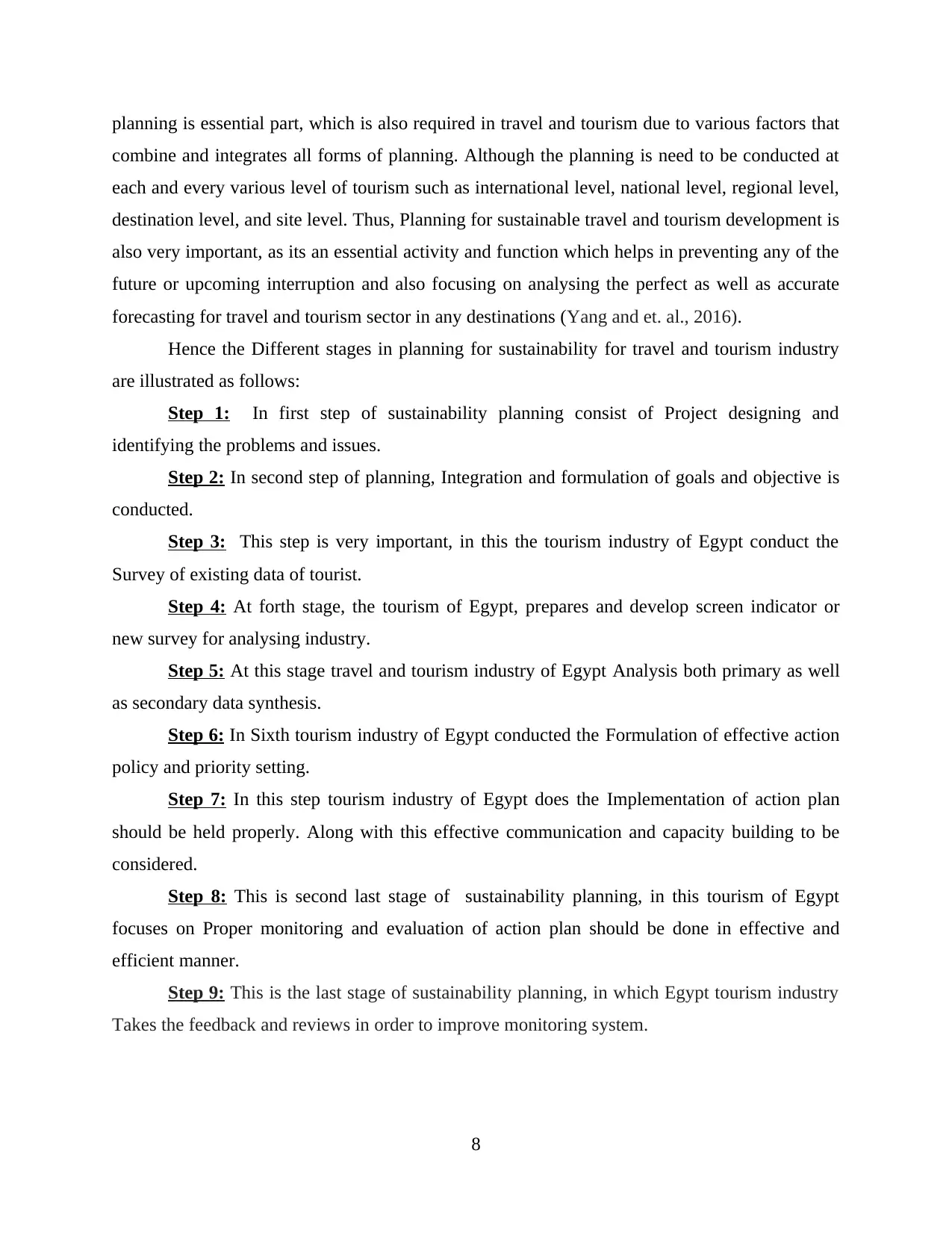
planning is essential part, which is also required in travel and tourism due to various factors that
combine and integrates all forms of planning. Although the planning is need to be conducted at
each and every various level of tourism such as international level, national level, regional level,
destination level, and site level. Thus, Planning for sustainable travel and tourism development is
also very important, as its an essential activity and function which helps in preventing any of the
future or upcoming interruption and also focusing on analysing the perfect as well as accurate
forecasting for travel and tourism sector in any destinations (Yang and et. al., 2016).
Hence the Different stages in planning for sustainability for travel and tourism industry
are illustrated as follows:
Step 1: In first step of sustainability planning consist of Project designing and
identifying the problems and issues.
Step 2: In second step of planning, Integration and formulation of goals and objective is
conducted.
Step 3: This step is very important, in this the tourism industry of Egypt conduct the
Survey of existing data of tourist.
Step 4: At forth stage, the tourism of Egypt, prepares and develop screen indicator or
new survey for analysing industry.
Step 5: At this stage travel and tourism industry of Egypt Analysis both primary as well
as secondary data synthesis.
Step 6: In Sixth tourism industry of Egypt conducted the Formulation of effective action
policy and priority setting.
Step 7: In this step tourism industry of Egypt does the Implementation of action plan
should be held properly. Along with this effective communication and capacity building to be
considered.
Step 8: This is second last stage of sustainability planning, in this tourism of Egypt
focuses on Proper monitoring and evaluation of action plan should be done in effective and
efficient manner.
Step 9: This is the last stage of sustainability planning, in which Egypt tourism industry
Takes the feedback and reviews in order to improve monitoring system.
8
combine and integrates all forms of planning. Although the planning is need to be conducted at
each and every various level of tourism such as international level, national level, regional level,
destination level, and site level. Thus, Planning for sustainable travel and tourism development is
also very important, as its an essential activity and function which helps in preventing any of the
future or upcoming interruption and also focusing on analysing the perfect as well as accurate
forecasting for travel and tourism sector in any destinations (Yang and et. al., 2016).
Hence the Different stages in planning for sustainability for travel and tourism industry
are illustrated as follows:
Step 1: In first step of sustainability planning consist of Project designing and
identifying the problems and issues.
Step 2: In second step of planning, Integration and formulation of goals and objective is
conducted.
Step 3: This step is very important, in this the tourism industry of Egypt conduct the
Survey of existing data of tourist.
Step 4: At forth stage, the tourism of Egypt, prepares and develop screen indicator or
new survey for analysing industry.
Step 5: At this stage travel and tourism industry of Egypt Analysis both primary as well
as secondary data synthesis.
Step 6: In Sixth tourism industry of Egypt conducted the Formulation of effective action
policy and priority setting.
Step 7: In this step tourism industry of Egypt does the Implementation of action plan
should be held properly. Along with this effective communication and capacity building to be
considered.
Step 8: This is second last stage of sustainability planning, in this tourism of Egypt
focuses on Proper monitoring and evaluation of action plan should be done in effective and
efficient manner.
Step 9: This is the last stage of sustainability planning, in which Egypt tourism industry
Takes the feedback and reviews in order to improve monitoring system.
8
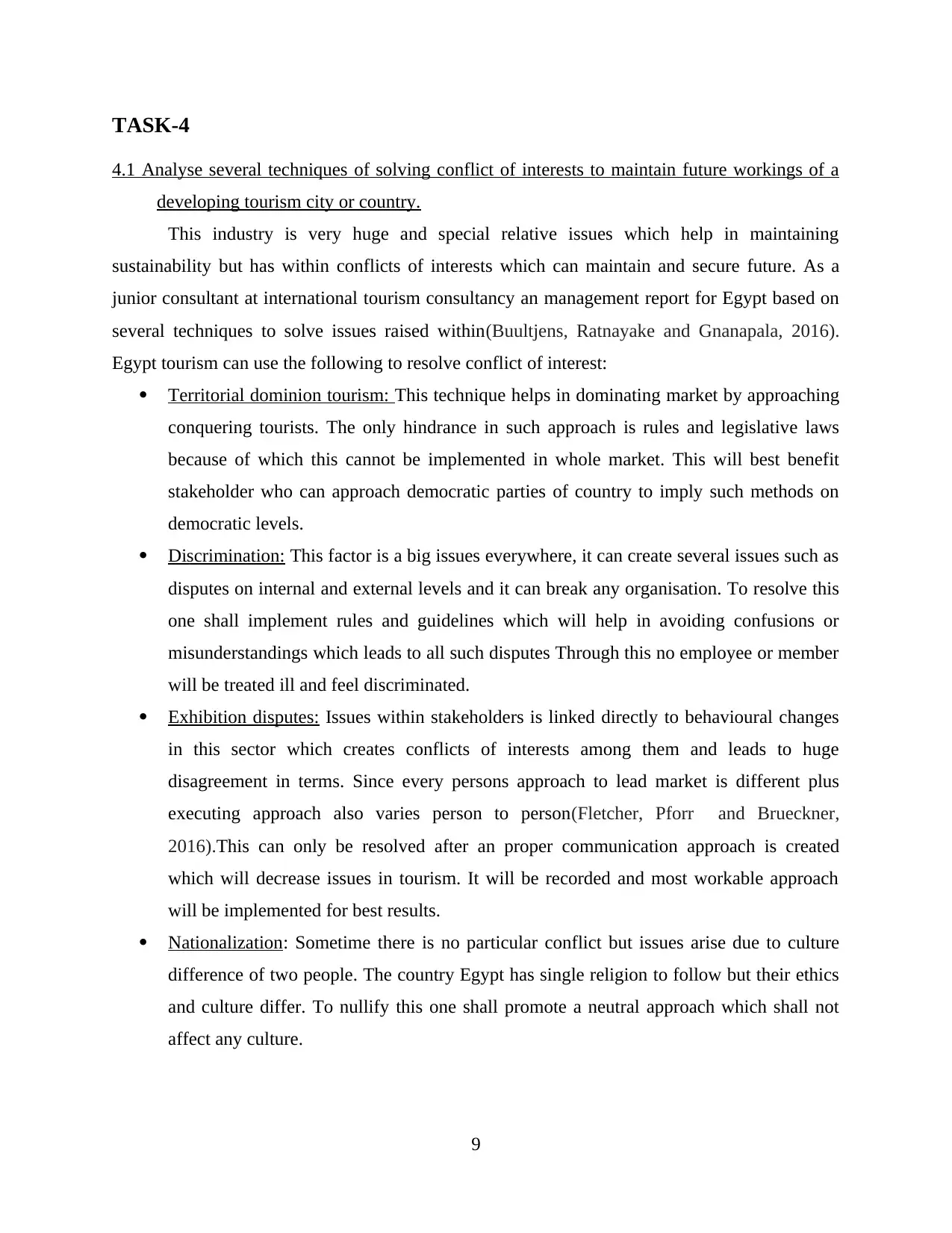
TASK-4
4.1 Analyse several techniques of solving conflict of interests to maintain future workings of a
developing tourism city or country.
This industry is very huge and special relative issues which help in maintaining
sustainability but has within conflicts of interests which can maintain and secure future. As a
junior consultant at international tourism consultancy an management report for Egypt based on
several techniques to solve issues raised within(Buultjens, Ratnayake and Gnanapala, 2016).
Egypt tourism can use the following to resolve conflict of interest:
Territorial dominion tourism: This technique helps in dominating market by approaching
conquering tourists. The only hindrance in such approach is rules and legislative laws
because of which this cannot be implemented in whole market. This will best benefit
stakeholder who can approach democratic parties of country to imply such methods on
democratic levels.
Discrimination: This factor is a big issues everywhere, it can create several issues such as
disputes on internal and external levels and it can break any organisation. To resolve this
one shall implement rules and guidelines which will help in avoiding confusions or
misunderstandings which leads to all such disputes Through this no employee or member
will be treated ill and feel discriminated.
Exhibition disputes: Issues within stakeholders is linked directly to behavioural changes
in this sector which creates conflicts of interests among them and leads to huge
disagreement in terms. Since every persons approach to lead market is different plus
executing approach also varies person to person(Fletcher, Pforr and Brueckner,
2016).This can only be resolved after an proper communication approach is created
which will decrease issues in tourism. It will be recorded and most workable approach
will be implemented for best results.
Nationalization: Sometime there is no particular conflict but issues arise due to culture
difference of two people. The country Egypt has single religion to follow but their ethics
and culture differ. To nullify this one shall promote a neutral approach which shall not
affect any culture.
9
4.1 Analyse several techniques of solving conflict of interests to maintain future workings of a
developing tourism city or country.
This industry is very huge and special relative issues which help in maintaining
sustainability but has within conflicts of interests which can maintain and secure future. As a
junior consultant at international tourism consultancy an management report for Egypt based on
several techniques to solve issues raised within(Buultjens, Ratnayake and Gnanapala, 2016).
Egypt tourism can use the following to resolve conflict of interest:
Territorial dominion tourism: This technique helps in dominating market by approaching
conquering tourists. The only hindrance in such approach is rules and legislative laws
because of which this cannot be implemented in whole market. This will best benefit
stakeholder who can approach democratic parties of country to imply such methods on
democratic levels.
Discrimination: This factor is a big issues everywhere, it can create several issues such as
disputes on internal and external levels and it can break any organisation. To resolve this
one shall implement rules and guidelines which will help in avoiding confusions or
misunderstandings which leads to all such disputes Through this no employee or member
will be treated ill and feel discriminated.
Exhibition disputes: Issues within stakeholders is linked directly to behavioural changes
in this sector which creates conflicts of interests among them and leads to huge
disagreement in terms. Since every persons approach to lead market is different plus
executing approach also varies person to person(Fletcher, Pforr and Brueckner,
2016).This can only be resolved after an proper communication approach is created
which will decrease issues in tourism. It will be recorded and most workable approach
will be implemented for best results.
Nationalization: Sometime there is no particular conflict but issues arise due to culture
difference of two people. The country Egypt has single religion to follow but their ethics
and culture differ. To nullify this one shall promote a neutral approach which shall not
affect any culture.
9
⊘ This is a preview!⊘
Do you want full access?
Subscribe today to unlock all pages.

Trusted by 1+ million students worldwide
1 out of 20
Related Documents
Your All-in-One AI-Powered Toolkit for Academic Success.
+13062052269
info@desklib.com
Available 24*7 on WhatsApp / Email
![[object Object]](/_next/static/media/star-bottom.7253800d.svg)
Unlock your academic potential
Copyright © 2020–2025 A2Z Services. All Rights Reserved. Developed and managed by ZUCOL.





